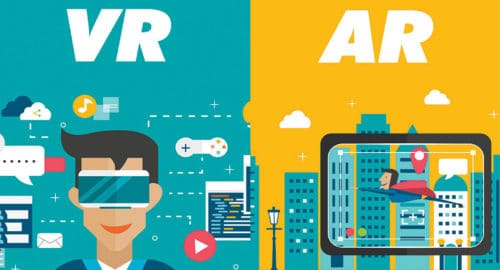Various market reports suggest that exponential strides in extended reality (XR) technology in the coming years are going to teleport mankind into a world of unimaginable illusion. Yet, like any other technology in its infancy, a lot of issues still need to be resolved for wide-scale adoption.
Remember how in 2016 Pokémon Go became a worldwide trend? Stories around it, to this day, are enough to explain the real-life impact of extended reality (XR) in the gaming sector. Fast forward to 2020, we already have several businesses developing XR applications beyond the realm of gaming for practical utility. Under the hood of XR, augmented reality (AR) and virtual reality (VR) are slowly changing the business landscape.
James Watson, chief marketing officer, Immerse, says, “As a new technology the challenge is to be able to demonstrate efficacy and commercial value of enterprise VR. Many of the technological challenges have been overcome; focus is now shifting towards commercialisation and positioning of the technology. There has been a shift from ‘Why should we consider VR?’ to ‘How do we go about using VR?’”
But which businesses can benefit from these technologies? This article explains these technologies, their applications in different sectors and how to start designing products for them.

AR versus VR
People often use terms like AR, VR and mixed reality (MR) interchangeably to just talk about anything that lies on the real virtual spectrum. It is important to understand their differences to fully grasp the benefits of these individual technologies and know what you need.
AR superimposes media (images, text and the like) onto the real world such that the user is still connected to the surroundings. Snapchat filters with hats or glasses that are highly popular these days utilise AR. Not every AR application uses recognition for sensing though; marker-less AR uses location-detection features like GPS and accelerometer for such purposes as finding nearby places. Cellphones like Asus Zenfone ARES and Google Nexus 6P are compatible with Google’s AR platform.
VR, on the other hand, is completely isolated from reality. VR creates the illusion that an image has depth by showing two slightly offset images separately to each eye of the user through a headset or similar device, which creates a simulated 3D digital environment. Frame rate of at least 60fps to process and render images without latency, and field-of-view (FOV) above hundred degrees to support user head or eye movement are some of the necessary considerations while developing an application.
Sound effects also need to be consistent with visuals. For high-end VR applications, sensors placed in the surroundings ensure high accuracy. MR is an amalgamation of the two for optimum results, like in Microsoft Hololens.
Raman Talwar, chief executive officer, Simulanis Solutions, says, “In VR, motion tracking raises the level of experience to a whole new level. With the concept of 6DOF (six degrees of freedom), a user can feel free to move and look around in the virtual world. In AR, the general technology of tracking is based on what is called simultaneous localisation and mapping (SLAM), where the camera orients itself to movement of the user.
“In AR, environmental understanding is based on points cloud sensed from camera and is based on the real world. While in VR, complete environment is generated virtually and nothing is real.”
Virtual expansion so far
Numerous businesses in various industries are already present while others are venturing into AR and VR now. Such companies as Imaginate, Immerse and Simulanis offer customised solutions to enterprises. Hemanth Satyanarayana, chief executive officer, Imaginate, says, “Increased computing power available on handheld devices along with depth-sensing features enable easier generation of AR experiences. Cost of smartglasses has reduced significantly with better performance. The variety of brands available has increased. Businesses are looking for faster design reviews, production cycles and quicker troubleshooting techniques.” Some of the prominent applications are discussed next.
Entertainment and gaming
This industry was the earliest adopter of XR and relied on fully-immersive experiences to thrive. Today, consumers can virtually experience live entertainment events, such as concerts, exhibitions and sports events, minus the crowd. For instance, in Denver Museum of Nature and Science, visitors get to see dinosaurs instead of their fossils.
Retail
With the advent of the Internet, e-commerce became popular due to the convenience that buyers got by shopping anytime, anywhere. Businesses are going one step ahead by letting customers try the item before purchase. One such example is Decor Matters that allows customers visualise furniture and decor items before making a purchase.
Education and training
Using XR for education provides students with a more realistic view and improves their understanding. Training imparted to newbies regarding proper utilisation of costly equipment in an industry can not only be complex but mishandling equipment can also cause monetary losses. Moreover, training for professions in fields like military, healthcare, aeronautics and the like often involves dangerous situations that may even be life-threatening.
In many areas today, all three military services (army, navy and air force) are employing AR and VR for vehicle simulation, flight simulation, battlefield simulation, medic training and more at a cheaper cost than most traditional methods.
Remote collaboration
Employees around the world can connect with each other for meetings in a way that makes both sides feel like they are in the same room. Data can also be accessed remotely whenever required.
Real estate
From easing the process of designing homes for architects and interior designers to letting potential buyers or tenants view properties virtually, AR and VR save time and improve understanding. For example, Trezi by SmartVizX allows remote collaboration for making better decisions while designing homes.
Healthcare
Medical students can perform surgeries on virtual patients. Also, diagnosing diseases becomes easier with medical imaging, allowing 3D representation of human bodies like in CT scan. VR can also be used to deal with post-traumatic stress disorder by virtually exposing the affected to the triggers that they get used to gradually.
Marketing
AR and VR enable captivating ways to engage with prospective customers and offer immersive interaction with products, which benefit companies. Owing to their potential, some of the biggest brands in the world have integrated them into their marketing strategy. McDonald’s in Sweden, for example, created a Happy Meal Box that folds into a VR headset.

Diving into new reality: getting started
To keep up with industry’s growth, businesses want good designers and developers to create high-quality experiences that are also practical and stress-free. It is a good practice for designers and developers to understand the basics of each others’ work. Since there are no predefined rules, there is immense scope for exploring new ideas. For beginners, a thorough understanding of technology and basic skills is a must. Knowledge in related fields like visual effects, gaming and architecture can be beneficial.
Prototyping beforehand lets you understand the flaws of your model for a possible application so that final products do not have to be altered. The device must be comfortable and lightweight. Talwar says, “To have a motivational and enjoyable VR experience, a good design is fundamental. A VR experience must be designed in such a way that the user feels comfortable and at ease. Currently, we are witnessing the growth of immersive devices with greater FOVs to mitigate motion sickness that may or may not occur, depending on usage.”
First step is ideation. Decide what you aim to achieve, that is, whether you are designing for AR or VR. Narrow down your focus by collaborating and sharing your ideas. Then, break your big project into small individual ones. Satyanarayana says, “Every application has its intended user that it is designed for. A technician who needs troubleshooting help using AR while operating a crane would require a design different from that of a desk user who would want to see a 3D model or crane in VR. Based on application, the solution needs to be designed with appropriate hardware as well, which is not uniform.”
Choices for inputs include gestures, voice, eye movements or hardware inputs like touch and click. Based on application, you may choose a high-resolution screen or headset (Oculus Rift, HTC Vive or PlayStation VR) or small screen (Google Cardboard or GearVR). Parameters for selection vary based on the device used to experience the user interface (UI).
Rapid prototyping is necessary to get direct feedback in early testing so that you know you are going in the right direction. Experiment with different tools, programs and equipment, and learn the ones that can be used for developing your application. If you are already familiar with some of the tools that can be employed, choose them to save time.
WebVR is a common tool that lets designers experience VR in a Web browser. Sketch to VR plugin can be used to create VR demos using Sketch. Spark AR can be used to create interactive AR even without code. For final design and development, Unity and Unreal Engine are popular choices.
In AR and VR, there are usually 3D elements that are not applied across a flat screen as in case of 2D design tools. A UV map is the 2D representation of the surface of a 3D model for adding colourful textures easily. Instructions (shaders) are given to a device to render an image and decide how realistic the elements need to look. As a designer, you must be familiar with the chosen hardware and understand how the user would interact with the UI in a 3D environment. UI elements may be fixed in a particular space or moved along with the user.
Talwar explains, “In AR, light estimation is based on real-world lighting, while in VR it is based on light sources we generate in our environment. Illumination of the virtual object has to change in the same way as illumination in the real world.” Finally, design wireframes with user-friendly graphics.
What next
Various market reports suggest that exponential strides in XR technology in the coming years are going to teleport mankind into a world of unimaginable illusion. Watson says, “Key factors driving demand for enterprise VR solutions are increase in use-cases highlighting the benefits of VR for enterprise (particularly in training field), data that can be attributed to enterprise VR to prove ROI, improved hardware, untethered headsets (no wires) that enable easy setup and scalability for enterprise (for example, Oculus Quest).”
This growth will be accelerated by 5G implementation and Edge cloud processing. American multinational Qualcomm is not only working on 5G but also envisions mobile XR becoming a reality, similar to smartphones.
So, what does it mean for SMEs? As quality of output and equipment rises, prices will go further down and fit well into the SME budget. SMEs need customised AR/VR solutions to suit their budget. Businesses need to evaluate if AR and VR can fulfil their ultimate objectives.
Yet, like any other technology in its infancy, a lot of issues still need to be resolved for wide-scale adoption. Talwar says, “Increase in production and scope for further developments for various accessories that support the VR experience, such as head mounting displays, smart glasses, digital controllers, sensors and ever-evolving hardware computer requirements, all these to an extent do impact adaptability of the technologies, as we might not know what is next and when.”
Technical issues include display and power consumption. Immersive experiences require large FOVs, which is possible with bulky and, hence, uncomfortable headsets. These technologies also require large amounts of user data for working, and businesses implementing them need to prevent misuse. XR can potentially replace other screens and when available to the common man in the future threaten social engagement, just like smartphones.






